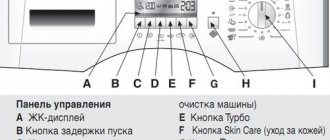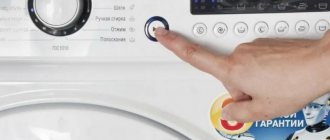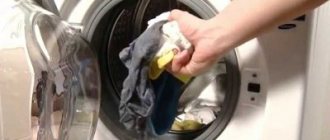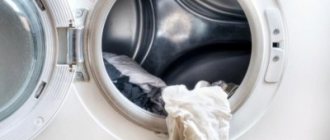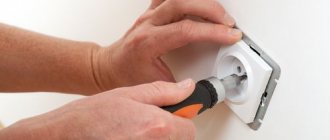The equipment of the Italian company Zanussi is reliable and easy to use, but even it can fail. No one is immune from breakdowns or manufacturing defects. Household appliances can also break down due to improper handling or makeshift repairs done without preparation. If, for example, a Zanussi washing machine does not drain water, then some users immediately begin to disassemble and clean it.
If you are not confident in your abilities, contact the service center. Or read our article. It will help you pinpoint the cause of the breakdown and develop a clear plan for repairing your washing machine yourself. Remember that first you always need to disconnect the equipment from the network, and only then begin diagnostics.
Diagnostics
Before starting repairs, you should check exactly how the drain or spin cycle is broken. This information will help you localize the location of the breakdown, which will allow you to repair your washing machine quickly and efficiently.
- Draining of liquid from the reservoir occurs extremely slowly.
- The next washing step does not start correctly.
- Water remains in the drum. The wash stops.
- After the end of the working cycle, a small amount of water remains at the bottom.
- No water is drained during the spin or rinse phase. It begins to decrease only at the end of the working cycle.
Malfunctions in the operation of the Zanussi washing machine can also occur due to the fault of the user. Make sure that the selected operating mode matches the type of laundry you are loading. Try changing the mode. This may be enough to start draining the water.
Never load the machine with more than the design allows. Not only will this disrupt operation, but it could also lead to more serious damage in the future.
The spin cycle in the washing machine does not work: how to fix it without repair, 5 steps
It is not always possible to repair a failed mechanism on your own.
To eliminate and correct minor problems, certain actions are required:
- Initially, check and adjust the functions set on the display.
- In delicate mode, start the spin cycle separately.
- Load laundry in accordance with washing machine standards. Remove excess laundry and properly distribute items in the bin. Restart the system.
- Carefully check clothes for large debris and small items in pockets before placing them in the tank. Periodically clean all elements of the drain pump.
- Timely pay attention to the following signs: the appearance of extraneous noise, creaking, slow drainage of waste water, regular failures when starting the button. All this can further lead to system malfunction.
Read more ► The washing machine does not turn on: causes of problems, what to do
Preparation for repair
A faulty water drainage system prevents the wash from completing. A washing machine filled with water simply stops working. The first thing to do in this case is to try to reboot it. To do this, unplug the machine, wait a few minutes, and plug it into a power outlet. These steps can help fix a minor software glitch.
If this does not help, then before starting the repair, do the following:
- unplug the power cord;
- remove all water from the drum.
You can scoop out all the liquid from the washing machine using a regular ladle, but this method is not very effective. If the blockage occurs in the sewer, then you can drain the water through the drain hose, having first disconnected it from the sewer pipe.
There is also an emergency hose located at the bottom of the housing. It is hidden behind a removable panel. Users who have experience in repairing such equipment can independently disassemble the washing machine and drain the water by removing the drain pipe and filter.
Online diagnostics of a washing machine
If your machine stops washing or rinsing clothes normally, then some kind of malfunction or breakdown has occurred.
You can try to find the problem yourself. Run diagnostics
Select which operation your washing machine does not perform:
1. Doesn’t drain 2. Doesn’t rotate the drum 3. Doesn’t spin clothes 4. Noises, knocks, buzzes when spinning 5. Doesn’t turn on
Checking the operation of the drain pump Is the drain pump of the washing machine working? Yes No I don’t know << Back
Clogged hoses in the washing machine If the sound corresponds to the normal sound that has always been observed when the device is working, the cause is probably a clog.
Was there a blockage in the drain hose? Yes
<< Back
The drain pump does not work! If the sound matches the normal sound of the drain pump, it is recommended that you check the drain filter first.
After cleaning, does the drain pump work and does the washing machine drain water? Not really
<< Back
Operation of the drain pump The sound of the pump is usually immediately audible and noticeable. If there is no sound, the pump is not working. We are looking for how to separately enable the water drainage program. As a rule, this is a separate option. After the program has been turned on, the pump should start working in 1-3 seconds. If everything is done correctly and the pump is operational, a buzzing sound will appear. If you hear no buzzing or other sounds when you turn on the program, the pump is probably faulty.
Is the washing machine drain pump working? Not really
<< Back
Clogged car hoses If you have identified a clog in the hoses, you need to disassemble them, clean them, and then reassemble everything.
Does the washing machine drain well? Not really
<< Back
Hurray, you did a great job, you fixed it.
<< Return to the beginning of diagnostics
The drain pump is faulty, call a professional.
<< Return to the beginning of the diagnosis.
The washing machine does not rotate the drum. During the operation of the washing machine, such a problem may occur. Each model has a different drum operation. It rotates according to a given algorithm, which is set by the program. This principle applies to spinning and washing. If you are not sure whether the drum is not spinning or whether it is working, put the laundry in the washing machine. Start the spin program. If the machine is running, it will first drain the water and then start spinning. In this case, a rotational process will be observed. If rotation is not visible, then check the belt. First, turn off the program, then unplug the wire from the outlet so that power does not flow into the device. Now you need to remove the back cover. You will need to carefully inspect the drum belt. It is quite easy to determine whether it is in the wrong position or damaged.
Is the washing machine belt torn or stretched? Not really
<< Back
Broken drum drive belt If the belt breaks, it will be immediately visible. There are also often cases when the belt simply stretches, which is why the drum, accordingly, does not rotate. Do not allow the machine to operate if the belt breaks. It is important to check whether it has wound around the engine pulley or broken the wiring to the engine. The heating element and temperature sensor may also be damaged if the belt does catch the wires. It is imperative to ensure that the belt model is original. If you choose an unsuitable or low-quality product, this will affect the performance of other devices. How do you know what kind of belt you have? There will be a marking written on the old one, compare it with the one indicated on the belt offered to you. You can also find out belt information by car model.
<< Return to the beginning of the diagnosis.
Washing machine motor malfunction If a malfunction is not found, the block with wires must be disconnected from the electric motor. Carefully remove it. We visually evaluate the engine. It may have melting, cracks, or other effects that clearly indicate damage. We call the windings of the tachogenerator and the engine. It is important to understand that you can fully study how correctly the engine operates and whether there is a malfunction only at the stand. If rotation does not occur, there may be a problem with more than just the motor. Sometimes the cause is a malfunctioning electronic module. If a short circuit occurs in the engine, the module could be damaged, while the engine remains operational. Also, the wires could be damaged.
<< Return to the beginning of the diagnosis.
Repairing a washing machine that does not spin clothes After completing the washing process, the washing machine may not spin properly or may not start spinning. Firstly, look, perhaps another mode is set, which does not involve turning on the spin cycle at all. This happens, for example, with programs related to washing woolen items and delicate fabrics. To check, run the spin cycle separately. If the washing machine does not drain water, we proceed to check the pump.
Does the washing machine now spin clothes? Not really
<< Back
Congratulations, you have solved your problem!
<< Return to the beginning of the diagnosis.
Repair of washing machines, imbalance Modern washing machines place the laundry on the drum before spinning. This is necessary for quality work. Check if this feature works. Sometimes a situation occurs when things get wrapped up in a ball that cannot be unwound automatically within a certain time. At this point the work stops. You need to unwind this laundry yourself, lay it out and continue operating the washing machine. In this case, it is important to turn off the machine, and then, when the laundry is laid out, turn on a separate spin program.
Does the washing machine now spin clothes? Not really
<< Back
Washing machine repair, drum drive repair Now you need to check the drum drive belt. We remove the cover and visually assess the condition of the belt. There should be no damage. If the tension is weak, the spin may not turn on. If you need to replace the belt, you should only replace it with the original one. After replacing, we try the program again.
Fault found, does the washing machine spin? Not really
<< Back
The engine or electronic module is faulty, call a repairman to your home.
<< Return to the beginning of the diagnosis.
The washing machine hums, makes noise during the spin cycle, rumbles, and makes a jet plane noise. If the washing machine makes noise during operation, making unusual sounds, it’s time to pay special attention to it. In this case, a visible breakdown or lack of functionality may not be observed, but the appearance of strange sounds indicates that it is time to look for a malfunction. It is important to understand that a new car that has just been delivered should be inspected for shipping bolts. If you forget to remove them, noise and vibration are inevitable. So, let's begin! We turn the washing machine drum and listen to extraneous sounds.
When rotating, do you hear extraneous noise, hum, balls rolling, does the drum move unevenly with slight jamming? Not really
<< Back
If the drum rotates and uncharacteristic sounds appear, including vibration, it’s time to check the bearings. If they malfunction, they will have to be replaced.
<< Return to the beginning of the diagnosis.
The counterweight of the washing machine has come loose. The fastening of the counterweights must also be of high quality. If they are “loose”, it’s time to eliminate this defect. In some cases, you can notice that the bolts that secure the stones are completely missing. In this case, the connectors for mounting will be visible. The bolts need to be found and put in place - they probably simply came loose. A rumble heard while the washing machine is operating may indicate that the bolts have partially loosened. To check the bolts, you can simply push the drum. If it is secure, the bolts are fine. If it moves, there is a defect.
Do you hear any noise, clanging or rattling noises when moving the washing machine tub? Not really
<< Back
The counterweight has come off
<< Return to the beginning of diagnostics
Checking the shock absorbers of the washing machine Checking the shock absorbers. If you hear vibration or excessive noise during the spin cycle, there may be a problem with the shock absorbers. Sometimes the washer moves. Now let's check the functionality. Remove the top cover. Click on the tank, move it five to seven centimeters down. A normal reaction will be observed if the tank rises sharply, jumping a little and stopping in its normal place. If this does not happen, the shock absorbers need to be replaced.
Are the shock absorbers of the washing machine working? Not really
<< Back
If a visible defect has not been identified, check whether a foreign object may have entered the machine. Replacing shock absorbers. The problem with shock absorbers wearing out occurs quite often over time.
<< Return to the beginning of the diagnosis.
Replacing washing machine shock absorbers. Malfunction and wear of shock absorbers is a fairly common phenomenon.
<< Return to the beginning of the diagnosis.
The washing machine does not turn on. It is worth trying to find the cause of the problem yourself and fix it. We start by connecting the device to the network. Next, click on the “network” button. In different car models, different indications are triggered: here either the display will start working, or, on the contrary, some other button.
Does the washing machine have an indicator? Not really
<< Back
Hatch lock lock (UBL) You can check it by turning on any of the programs. We choose what we will use. Click on the corresponding button. Don't forget to pay attention to the inclusion. As a rule, the process of activating a function is characterized by the presence of a certain sound, for example a click, with which the device makes it clear that pressing again is not necessary and the machine is already working. If there is no sound, the button may be broken. In this case, the main thing that must be done is to block the hatch and start working. If this happens, everything is fine.
The washing machine is blocking the hatch and the UBL is triggered? Not really
<< Back
Water fill valve malfunction
<< Return to the beginning of the diagnosis.
The washing machine hatch does not lock
<< Return to the beginning of the diagnosis.
No indication Checking the electrical circuit. If you notice that the washing machine does not respond to being turned on, it is first recommended to check the power supply. The outlet may be faulty. Try connecting another device. If the outlet works, you need to check whether the circuit that conducts energy through the washing machine from one element to another is intact. To do this, you will need a multimeter, which will help you fully analyze the ability to respond to an electrical signal at several stages of operation. If there is no network connection anywhere, this is probably the problem. We carry out this manipulation until we reach the electronic module. If we are talking about an old washing machine, here it will look like the device’s program. When you turn on the button, there should be no breaks in the circuit. If the circuit works, everything is fine electrically.
Is the washing machine's power supply OK? Not really
<< Back
Repair of electronic module (unit)
<< Return to the beginning of diagnostics
Contact circuit fault
<< Return to the beginning of diagnostics
| Fault code. | Description. | Causes and elimination. |
| E11 | There is no water filling during the wash cycle (the level in the tank has not been reached within the allotted period). |
|
| E13 | There is a water leak into the washing machine tray. | Check the presence of water in the pan. |
| E21 | The water was not drained from the tank within 10 minutes. |
|
| E23 | The control triac of the drain pump is faulty (located on the electronic controller). | Check and, if necessary, replace the specified triac or controller. |
| E24 | Defect in the drain pump triac control circuit (located on the electronic controller). | Check the serviceability of the elements of the specified circuit. |
| E31 | Pressure sensor faulty. | The frequency of the pressure sensor is outside the permissible limits, there is a break in the electrical wiring.
|
| E32 | Pressure sensor calibration problems. | After initial calibration, the water level is outside the range of 0-66 mm and the anti-boil value has not been reached.
|
| E33 | Inconsistency in the operation of water level sensors (the sensor protecting the heating element from turning on the latter without water and the first level sensor). | The most likely causes of such an error may be:
|
| E34 | Inconsistency between the pressure switch and the anti-boil level 2. | The error has existed for more than 60 seconds.
|
| E35 | The water level in the tank is higher than permissible. | During the process of filling the water, the so-called overflow level was reached (the switch was open for more than 15 seconds). Check and, if necessary, replace the pressure switch. |
| E36 | The heating element protection level sensor (AB S) is faulty. | Check the specified sensor. |
| E37 | Malfunction of the first water level sensor (L1 S). | Check the specified sensor. |
| E38 |
| Clean or replace the pressure switch tube. |
| E39 | Malfunction of the overflow level sensor (HV1 S). | Check the specified sensor. |
| E3A | Heating element relay malfunction. | Replace the electronic unit. |
| E41 | The hatch is open or not closed tightly. | Close the hatch tightly. |
| E42 | The hatch lock is faulty. | Check the hatch lock (UBL). |
| E43 | The control triac (located on the electronic controller) of the hatch lock is faulty. | Check the serviceability of the control triac of the hatch lock. |
| E44 | The sunroof closing sensor is faulty. | Check the specified sensor. |
| E45 | The elements of the hatch lock triac control circuit (located on the electronic controller) are faulty. | Check the elements of the hatch lock control circuit. |
| E51 | Short circuit in the control triac of the drive motor (located on the electronic controller). | Check and, if necessary, replace the drive motor control triac. |
| E52 | The signal from the tachogenerator of the drive motor is not sent to the electronic controller. |
|
| E53 | The elements of the drive motor triac control circuit (located on the electronic controller) are faulty. | Check the drive motor triac controls. |
| E54 | “Sticking” of one of the contact groups of the reverse relay (there are two in total) of the drive motor (located on the electronic controller). | Check and, if necessary, replace the reverse relay. |
| E55 | Open circuit in the engine circuit. |
|
| E56 |
| Replace the tachometer generator. |
| E57 | The current exceeds the threshold value >15A. |
|
| E58 | The motor phase current exceeds the threshold value>4.5A. |
|
| E59 | After setting a new rotation speed other than zero, there is no tachometer signal for 3 seconds. |
|
| E5A | The cooling radiator temperature exceeds the threshold value (88°C). | Replace the electronic unit. |
| E5B | The DC bus voltage drops below the threshold (<175V). |
|
| E5C | The DC bus voltage rises above the threshold value (>430V). | Change the electronic unit. |
| E5D | FCV is unable to receive and/or send a message within 2 seconds. | Replace the electronic module. |
| E5E | Communication error between FCV control controller and main PCB. | Change the electronic controller. |
| E5F | The FCV control board continuously requests configuration parameters due to repeated resets. |
|
| E61 | When heating water, its temperature does not reach the set value over a certain period. | ! This code is not available for reading in the normal operating mode of the SMA - it is displayed only in the diagnostic mode. If necessary, you can check the heating element - its resistance should be about 30 Ohms (at room temperature). |
| E62 | While heating the water, its temperature reached more than 88°C in 5 minutes. |
|
| E66 | The heating element relay is faulty. | Check and, if necessary, replace both the heating element relay itself and its control circuits. |
| E68 | The leakage current in the washing machine is too high. | Replace the heating element or replace other components. |
| E71 | The resistance of the temperature sensor is outside the specified limits. |
|
| E74 | NTC (temperature sensor) is in the wrong position in the tank. | Check the position of the temperature sensor. |
| E82 | Selector position selection error. | The electronic unit is faulty (incorrect configuration data), selector, electrical wiring. |
| E83 | Error reading data from the selector (this code can only be read in diagnostic mode). | Incorrect machine configuration, replace the electronic unit. |
| E84 |
| Replace the electronic module. |
| E85 |
|
|
| E91 | Communication error between the user interface and the main unit. | Change the electronic controller. |
| E92 | Inconsistency between the user interface and the main unit. | Replace the electronic unit. |
| E93 | Configuration error. | Such a defect can be eliminated by entering the correct configuration code. |
| E94 | Errors in SMA and cycle (program) configuration. | It is necessary to overwrite the non-volatile memory of the controller or replace this board. |
| E95 | Communication error between the processor and non-volatile memory located on the electronic controller. |
|
| E96 | Mismatch between the configuration of the electronic controller and the external elements that are connected to it (or not). | Check the conformity of the configuration of the electronic controller and its external elements. |
| E97 | Inconsistency in the operation of the program selector and the software of the electronic controller. |
|
| E98 | Mismatch between the engine control unit and the main electronics. |
|
| E99 | Abnormal connection between the sound unit and the input/output electronics. |
|
| E9A | The hardware/software between the speaker and the input/output electronics is faulty. | Replace the electronic unit. |
| EA1 | DSP system malfunction. |
|
| EA2 | DSP recognition error. | Replace the main unit. |
| EA3 | The DSP cannot lock the motor pulley. |
|
| EA4 | DSP fault. |
|
| EA5 | DSP thyristor faulty. | Replace the main unit. |
| EA6 | There is no signal to spin the reel for the first 30 seconds. |
|
| EB1 | The frequency of the supply network does not correspond to the permissible frequency. | Check the power supply parameters. |
| EB2 | The supply voltage is above the permissible limit | Check the power supply parameters. |
| EB3 | The supply voltage is below the permissible limit. | Check the power supply parameters. |
| EBE | The safety circuit relay is faulty. | Replace the electronic unit. |
| EBF | Protection circuit recognition error. | Change the control module. |
| EC1 | The fill valve is blocked. |
|
| EC2 | Malfunction of the water transparency sensor (if equipped). | Replace the turbidity sensor. |
| EF1 |
|
|
| EF2 |
|
|
| EF3 |
|
|
| EF4 | There is no signal from the flow sensor when the fill valves are turned on. | The water tap is closed or there is insufficient pressure in the water supply. |
| EF5 | Spin cycle interrupted, unbalance too large >1200 g. |
|
| EH1 | The supply voltage frequency is outside the permissible limits. |
|
| EH2 |
| Change the electronic module. |
| EH3 |
| Change the controller. |
| EHE | The safety circuit relay is faulty. | Replace the control module. |
| EHF | Protection circuit recognition error. | Change the electronic unit. |
Do you wash your shoes in the machine?
Oh yes! No
Blockage
An error in the operation of equipment can occur at any stage of operation. The most common reason why a Zanussi washing machine does not drain water or spin clothes is a blockage.
It can occur in such elements of the water drainage system as:
- drain hose;
- filter;
- pump impeller;
- drain pipe.
Breakdowns of this type can be easily repaired at home. The cleaning method depends on the nature of the problem. In some cases it is necessary to use specialized equipment.
Drain system clogged
If water stagnates in the tank, you need to check the drain hose or filter. Clogging of these parts prevents the outflow of liquid, making spinning impossible. To troubleshoot the problem, perform the following steps:
- Inspect the filter. This part is located at the front of the device. It is hidden by a plastic cover or decorative panel. To access the filter, you need to remove the cover. After this, the part is removed from the mounting socket. First, place a low container under the filter. When unscrewing the element, water flows out of the hole.
- Clean the filter of debris and rinse it under running water. Treat the seat where dirt often accumulates.
- If the problem of water stagnation persists, they proceed to checking the pipe and connecting the tank to the pump. To gain access to this unit, unscrew the bolts securing the drain device.
- Take out the pipe. As when dismantling the filter, it is necessary to place a container in advance to collect residual water. The pipe is compressed, identifying possible blockages. They look like compacted areas. If blockages are present, the pipe is washed.
- Reinstall the removed parts and check the operation of the washing machine.
Cleaning the drain filter and pipe
The filter is located at the bottom of the washing machine. It is hidden behind a removable panel made of the same material as the body. If you cannot find it and open it yourself, use the instructions. She will tell you what to do. Behind the panel there is an emergency hose and a pump filter. Please note that the filter is sealed with a rubber gasket.
In order to remove it, you need to apply some force. However, don't overdo it; some blockages may also prevent it from being removed. Once you have the filter in your hands, you can clean it by hand or with a brush.
The drain pipe is located in the machine body itself. It is highly not recommended to dismantle it yourself. Call specialists to your home. If you are confident in your abilities, then using the instructions, you can disassemble the washing machine and clean this part yourself.
Inspection of the pump (pump)
The failure of this part can only be determined by the residual principle. Except in cases where it was preceded by the following events:
- extraneous sounds during draining and spinning;
- repeated minor malfunctions in the operation of the Zanussi washing machine.
Although you can replace the drain pump yourself, this should only be done when the warranty period has long expired. Otherwise, contact the service center. Repairing this type of fault takes a short amount of time.
Two breakdowns of the drainage system
Much serious damage to the washing unit is likely when the laundry is not just left unwrung in a small amount of water, but floats in it.
If the washing machine does not drain the water from the tank, problems have arisen in the drainage system:
- The drain filter, hose, and pipe section are clogged
- Each of these parts or the drain pump (pump) has broken down.
It will not be difficult to remove a blockage in the drain filter (and this must be done constantly as a warning). It is more difficult to get rid of a problem with the drain hose going into the sewer. It is even more difficult to disassemble the machine and clean the section of pipe coming from the pump.
As for replacing the pump itself (it often “burns out”), only a professional with experience can do it.
For more information about the problem of lack of water drainage, read “The washing machine does not drain water.”
Hardware failures
Failure of the electronic elements of a washing machine is always associated with large expenses. No one will repair these devices. Craftsmen prefer to simply replace broken components. A faulty control unit can be recognized by the absence of signals on the front panel or by system error codes.
This type of breakdown also includes malfunctions of the water level sensor in the drum. Its malfunction leads to disruption of the drain and spin cycles due to the fact that it is directly connected to the pump. This part cannot be repaired. It can only be replaced at official Zanussi service centers.
What malfunction “turned off” the spin cycle?
The lack of spin on Zanussi washing machines does not always indicate serious problems. Sometimes the problem is simple user inattention or a broken drive belt, and the situation can be corrected in a couple of minutes. However, there are more serious reasons for freezing after rinsing:
- the tachogenerator (Hall sensor) is burnt out;
- the electric brushes are worn out;
- the winding on the motor is damaged;
- The triac responsible for the engine or the entire control board as a whole has failed.
Spin may not work on Zanussi due to problems with the motor, drive belt and control module.
To diagnose a washing machine, you need to consistently check all possible problems. It’s better to start with the simplest thing - eliminating user error, and finish with diagnosing the control board. Let's look at all the steps and instructions in more detail.
Other faults
Failures of this type are less common. They are usually associated with the secondary systems of the washing machine. This type of breakdown includes:
- drum bearing failure;
- malfunctions in the cleaning agent supply system;
- scale on the heating element;
- door lock.
It is extremely easy to determine whether a bearing is faulty. Spin the drum by hand. It will move with great difficulty, making grinding sounds. Bearings can be easily replaced at home, if disassembling such a device is not difficult for you.
A jammed door can be opened in several ways:
- Manually. Just use a thin metal ruler or spatula.
- Programmatically . Turn on the “rinse” mode. At the end of the cycle the door should open.
- Reboot . Unplug your device, then plug it back in after a few minutes.
Repair steps: Zanussi SMA does not press
Make sure the drain assembly is in good working order.
The spin mode is activated when the water in the tank has been drained.
Checking Tubular type heating element
If water is drained, check the tubular type heating element with a continuity tester. To access the tubular-type heating element, remove one of the walls located on the sides of the housing. Breakage The tubular type heating element blocks the operation of the SMA. This tubular type heating element needs to be replaced.
Checking the electric motor
To access the electric motor, the housing walls must be removed. Before dismantling the motor, it is best to photograph the position of the wires and fasteners. Now you can remove the drive belt, disconnect the terminal with electrical wires, and unscrew the fastening screws.
Carefully remove the motor from the skids and unscrew the commutator brushes. With prolonged use, the brushes wear out, the motor loses power, and the SMA cannot wring out the laundry well. Worn brushes (less than 5mm long) need to be replaced. If the brushes are longer than 5 mm, the cause of the breakdown may be a leak on the motor housing. After eliminating the damage, install the motor on the skids and fasten it in the reverse order.
Checking
Without assembling the walls of the case, we connect the SMA to the network and make sure that the spin mode is working properly. Now you can turn off the washer and assemble the entire body.
Electronic module
It is not often that the cause of a breakdown in spin mode can be damage to the electronic module. It needs to be replaced.
Prevention of breakdowns
You can extend the life of your Zanussi washing machine by following a few simple recommendations from experts. Wash clothes in small batches. Heavy weight leads to rapid wear of bearings.
Use products that prevent the formation of scale on the heating element. If the voltage in your electrical network fluctuates, use stabilizers. This will help protect electronics from damage. And most importantly, clean the filter several times a year. By following these recommendations, you can avoid situations where the washing machine stops draining water during the spin cycle.





